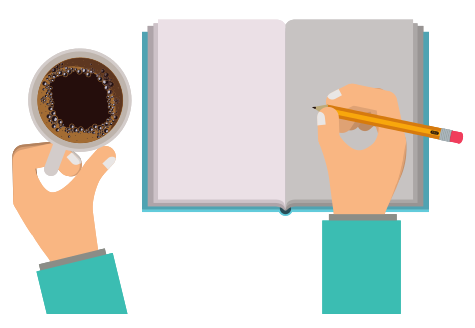
Notetaking, a good habit, keeps college students’ courses and lessons organized. On-campus and distance learners write down notes logically according to importance, relevance, and priority.
Students write at an average of approximately 0.3 to 0.4 words per second; however, the instructor speaks at a pace of around two to three words per second. Unless your professor chooses to talk a little slower or you have above-average shorthand skills, you need the right processes and methods for taking notes.
Explore our in-depth feature on notetaking! Use these page jumps for easy navigation:
Advantages of Effective Notetaking Techniques
What to Write
Digital Notetaking
Types of Notetaking Techniques
* The Cornell System
* The Mapping System
* The Outlining Method
* The Charting System
* The Sentence Method
Making The Most Out Of Your Notes

Advantages of Effective Notetaking Techniques

Messy lecture notes are a pain to read; oftentimes you lose the crucial information you need for an exam or research. For this reason, notetaking is an essential part of every college student’s journey. Not only does effective notetaking enhance your comprehension and memory; it also promotes discipline and organization, and raises your chances of succeeding in college!
Notetaking techniques impact the way you access an overwhelming amount of information. These are some of its benefits:
- A series of clear and well-formatted notes does away with wordy, insufficient, and vast content.
- Well-organized notes make presentations easy.
- Generally, notetaking eliminates the feeling of distraction and sleepiness in online classes.
- It improves your retention and reading comprehension.
- It promotes active listening and engagement in class, so you stay alert and proactive.
According to a study, learners who traditionally write notes perform better in exams than those who do it digitally. Manually written notes tend to be recalled at a faster rate, especially with a memory rehearsal. As such, well-organized notes are vital in your exam preparations.
It is to a student’s advantage to learn notetaking techniques before going to college. The perfect way to prepare for post-secondary education is to acquire college-level notetaking and organization skills.

What to Write

Notetaking is a skill to master. When taking notes, focus on new, meaningful, and relevant information. Here are the basic parts of a college lecture that you should focus on when taking notes:
- Introductory statements that generally include an outline of the topic overview
- Signal phrases and statements such as “A major cause of…”, “In summary,” or “There are five main…”
- Repeated concepts or highlighted words
- Gestures that emphasize specific parts of a statement
- Final words, observations, and conclusions
For an effective notetaking strategy, focus on these components:
Definitions
These are the main points in every discussion. They are repetitively described or mentioned in every context of the lecture. Unless you are confident that you already know the definition of a specific term, write it down.
Important Dates
Important dates paint a chronology of events to help you comprehend the context of an occurrence. For example, knowing Albert Einstein’s date of birth enables you to identify his milestones in relevance to the trends during that period.
Theories
Any theoretical statements or frameworks must be written in your notes. Most of the time, these are the main points in every discussion.
Images
A short description or statement of a painting or image can help you memorize and understand ideas better.
Arguments and Debates
Take note of the pros and cons to help you compare ideas and create a precise thought process.
Names of People
Associating names with key ideas and events help you better recall them.

Digital Notetaking

While it has its downsides, notetaking using a laptop or tablet—especially those with excellent speed and memory—makes the task convenient. Here are the software applications and mobile programs that students, particularly distance learners, can use to create well-organized notes.
Audio Notetaker is a tool used to record audio from a lecturer or another virtual source such as YouTube or Skype. It is only built for personal computers and features customized outputs, real-time note-taking, and screen captures. Also, it has presentation tools and advanced playback features for added versatility.
Evernote is an iOS-based tool that, for no extra charge, records audio and scans handwritten notes.
OneNote organizes data and stores it for unlimited use. It is a customizable application as part of the Microsoft Office Suite. It has a “data citation” feature for every snippet of information that is copied from the Internet.
Simplenote’s compatibility with several applications allows for seamless syncing or sharing of notes. All notes recorded online or on your mobile device automatically sync with Simplenotes.
SpiderScribe is an app integrated with Flash. It is a digital mind-mapping platform that allows importing and embedding data such as images, maps, and videos. A single user can create up to three maps for free.
WorkFlowy is a word processor, but you can customize and turn it into a useful notetaking app. You can nest pages, put them together in a bullet list, and access them as systematically organized information. You can select the data you wish to view and search for information easily.

Types of Notetaking Techniques

There is no right or wrong format to use when taking notes, but remember that the method you use can significantly impact the way you learn and process information.
Don’t be afraid to try the best technique that works for you! Here are five types of notetaking techniques you can explore:
The Cornell System
The Cornell Method is an easy but powerful system that promotes better memory recall by organizing lecture notes into easy-to-remember summaries. It holds together the main points, the outline, the essential details, and the study cues in a single place.
Advantages:
- Distance learners can pull out major points, concepts, or ideas.
- Lecture notes are neatly summarized, well-organized, and easy to review.
Structure:
Divide your paper into three parts. The largest section should hold the most crucial information. The narrow column on the right side should have the “cues” or questions that you can use to review the notes. Write a summary of your insights on the remaining part of the paper.

The Mapping System
The Mapping Notetaking System is a visual method of organizing lecture notes and identifies the relationships between concepts. It is presented as flowcharts, T-charts, charts, timelines, graphic organizers, Venn Diagrams, and tables that are suitable for visual learners.
Concept Maps are ideal in lectures that explain the relationship between ideas, examine information, and compare or contrast them.
Advantages:
- Compatible for visual learners
- Helps online students easily recall ideas
Structure:
There isn’t a definite way to create concept maps. You can take a piece of paper, write the subject information on the middle part, and draw lines to point the subtopics that originate from the main idea. This structure shows you how the topics are linked.

The Outlining Method
The Outlining System of Notetaking utilizes headings and bullet points to arrange concepts. This process applies to subjects that involve numerous details. It works best for students who learn and recall information better with a simple, straightforward, and clean notetaking structure.
Advantages:
- Well-organized lecture notes
- Presents the relationships between main topics and subtopics
Structure:
Begin by selecting four or five main points and write their subsections. Whether you utilize bullet points or the Roman Numerals, outlining helps you determine hierarchical relationships between concepts. For example, in a science lecture, you can write the name of notable physicists and below them, their discoveries or scientific milestones. Under each item, write a short description. Outlining also works when you take notes directly from a book.

The Charting System
The Charting Notetaking Method categorizes numerous concepts to highlight their differences.
It is useful for writing facts and statistics and making chapter summaries to review for exams.
Advantages:
- Highlights essential pieces of information for each subject
- Organizes facts so that they are easier to review
- Reduced writing time
Structure:
Create columns on a piece of paper and label them by category. Write the information on the proper column and under the right category.

The Sentence Method
The Sentence Note-Taking way is merely writing down per topic as a note sentence. This system works perfectly for the fast-paced lecture, where a lot of topics are being discussed. It is considered one of the easiest methods of writing down notes, important for distributing which pieces of information from a lesson is significant by swiftly covering information and essential details.
Advantages:
- Helps online students tackle an abundance of information
- Simplifies information for students to review and study easily
Structure:
Arrange your lecture notes using headings. This is ideal if you are a visual or auditory learner. You can pair this technique up with the Cornell system.

Making The Most Out Of Your Notes

Have you identified which note-taking method works best for you? If yes, how do you get the most out of your lecture notes? There are three different ways to boost your class notes:
- Recall and review a small part of your notes daily. Avoid cramming right before your scheduled exams.
- Review your lecture notes within the first 24 hours after your discussion. You have better chances of remembering them within this period.
- Use your notes when completing assignments or doing research.
It’s easy to talk about notetaking methods, but the biggest takeaway is that the technique you choose should help you quickly find and understand information.
